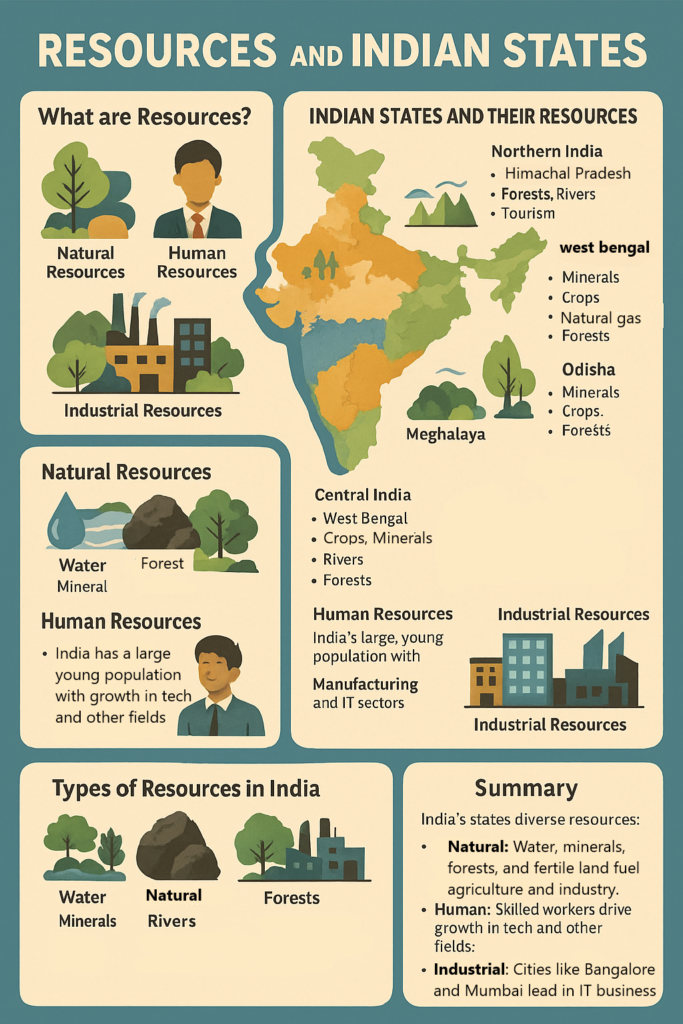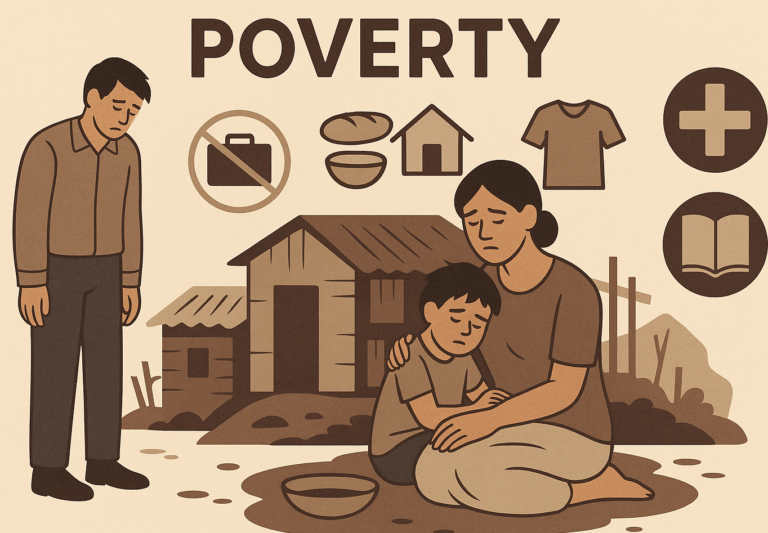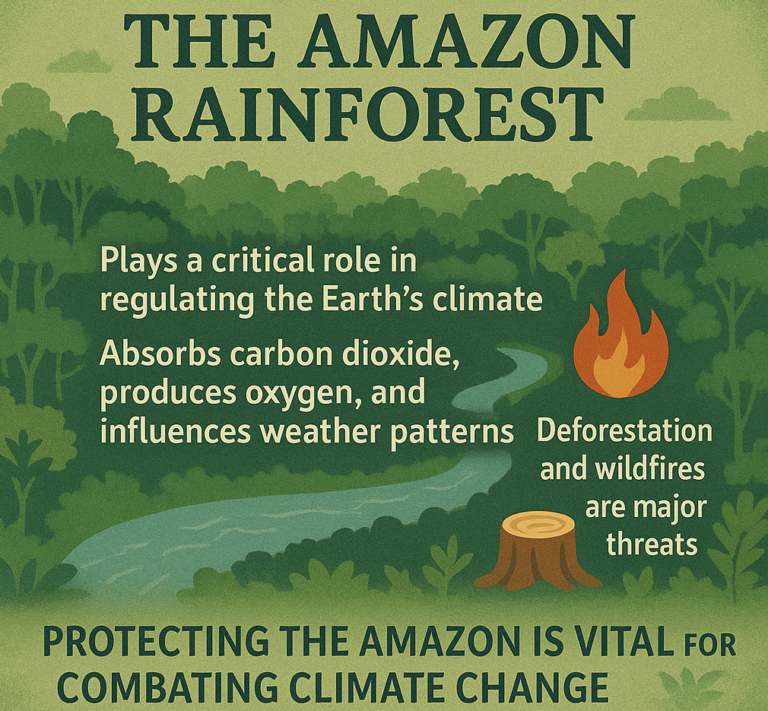1. What are Resources?
Resources are things that people can use to make life better. These could be things found in nature, like water, land, or minerals, or things people create, like factories, technology, and skills.
In the context of Indian states, resources refer to the natural resources (like water, soil, minerals) and human resources (like people’s skills, knowledge, and labor) that each state has and uses to grow their economy.

2. Indian States and Their Resources
India is made up of 28 states and 8 union territories, each with its own unique resources that help in their economic development. Let’s explore some of the states and the resources they are known for:
Northern India
- Himachal Pradesh:
- Resources:
- Forests: Known for its forest resources (timber, medicinal plants).
- Water Resources: Plenty of rivers, like the Beas and Satluj, provide hydroelectric power.
- Tourism: Beautiful mountains like the Himalayas attract tourists for adventure sports and religious tourism.
- Resources:
- Uttarakhand:
- Resources:
- Water Resources: Major rivers like Ganga and Yamuna flow through the state, which helps in hydropower generation.
- Forest Resources: The state has rich forest cover, providing timber, herbs, and medicinal plants.
- Minerals: It has rock salt and building materials.
- Resources:
- Punjab:
- Resources:
- Agriculture: Known as the “Granary of India,” it has fertile land and is a major producer of wheat, rice, and cotton.
- Water Resources: Rivers like the Sutlej and Ravi provide irrigation for farming.
- Industry: It has a growing textile and manufacturing sector.
- Resources:
Western India
- Maharashtra:
- Resources:
- Minerals: Maharashtra is rich in coal, manganese, and limestone.
- Agriculture: Crops like sugarcane, cotton, and fruits are grown here.
- Industry: The state is an industrial hub, with Mumbai being the financial capital of India.
- Resources:
- Gujarat:
- Resources:
- Petroleum: Gujarat has large oil and natural gas reserves, especially near Kutch and Saurashtra.
- Agriculture: Known for producing cotton, groundnut, and cereals.
- Salt: Gujarat is one of the largest producers of salt in India, especially from the Rann of Kutch.
- Resources:
Southern India
- Tamil Nadu:
- Resources:
- Agriculture: Major crops include rice, tobacco, and spices like black pepper.
- Industry: Tamil Nadu has a strong textile industry and is a leading producer of automobiles.
- Minerals: Rich in limestone, used in cement production.
- Resources:
- Karnataka:
- Resources:
- Minerals: Karnataka is known for its rich deposits of iron ore and manganese.
- Agriculture: Major crops include coffee, groundnut, and cotton.
- Technology: Bangalore, the capital of Karnataka, is known as the Silicon Valley of India because of its growing IT industry.
- Resources:
- Andhra Pradesh:
- Resources:
- Agriculture: Known for rice, groundnut, tobacco, and cotton.
- Minerals: Andhra Pradesh has large deposits of limestone and bauxite.
- Aquaculture: The state has a thriving fisheries industry due to its long coastline.
- Resources:
Eastern India
- West Bengal:
- Resources:
- Agriculture: Known for producing rice, jute, and tea from the Darjeeling region.
- Minerals: Rich in coal and iron ore.
- Industries: Kolkata is a major industrial and commercial hub.
- Resources:
- Odisha:
- Resources:
- Minerals: Odisha is rich in iron ore, coal, bauxite, and chromite.
- Water Resources: Rivers like the Mahanadi provide water for irrigation.
- Agriculture: Crops like rice, maize, and groundnut are grown.
- Resources:
Central India
- Chhattisgarh:
- Resources:
- Minerals: Chhattisgarh is rich in coal, iron ore, and bauxite.
- Water Resources: The Mahanadi river supports agriculture and industry.
- Forests: The state has extensive forests that provide timber and medicinal plants.
- Madhya Pradesh:
- Resources:
- Minerals: Known for coal, diamonds, and limestone.
- Agriculture: Major producer of wheat, rice, soya bean, and cotton.
- Forests: Rich in forest resources providing timber and bamboo.
Northeastern India
- Assam:
- Resources:
- Tea: Assam is world-famous for its tea plantations.
- Oil and Natural Gas: It has significant oil reserves, especially around Dibrugarh.
- Agriculture: Crops like rice, jute, and fruits are grown.
- Meghalaya:
- Resources:
- Coal: Meghalaya has large deposits of coal.
- Water Resources: It is known for its waterfalls and natural springs.
- Agriculture: Major crops include pineapple and betel nut.
3. Types of Resources in India
- Natural Resources:
- Water: Rivers like the Ganga, Yamuna, and Godavari are important for agriculture, industries, and daily needs.
- Minerals: Coal, iron ore, bauxite, and limestone are abundant in many states.
- Forests: Forests provide timber, medicinal plants, and biodiversity.
- Land: Fertile land in states like Punjab and Uttar Pradesh is used for farming.
- Human Resources:
- India has a large young population with a growing skilled workforce in education, technology, and agriculture.
- Industrial Resources:
- India has a growing manufacturing and service sector, with cities like Bangalore, Hyderabad, and Mumbai leading in IT and business services.
Summary:
- Indian states are rich in a wide variety of natural resources like water, minerals, forests, and fertile land, which help each state grow economically.
- Each state has its own specialization—for example, Punjab is known for agriculture, Gujarat for petroleum, and Karnataka for IT.
- Human resources, like skilled workers, are also essential in driving economic growth, particularly in technology and industries.
By using these resources wisely, India can continue to grow and develop, creating more opportunities for its people.











